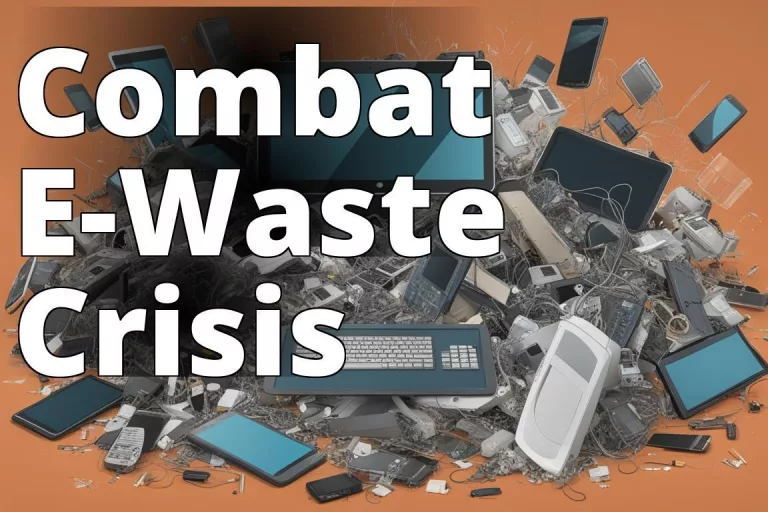E-waste, short for electronic waste, encompasses a wide range of discarded electronic devices, from smartphones to refrigerators. It’s not just about the sheer volume but the velocity with which these items transition from indispensable to disposable. The rapid tech evolution and planned obsolescence ensure a continuous flow of e-waste, posing significant challenges to waste management systems worldwide.
Learn about E-Waste Management and Recycling
- E-waste is electronic waste that needs proper management.
- The article discusses the impacts, benefits, challenges, and solutions of recycling e-waste.
- Discover ways to reduce and recycle e-waste effectively.
Insider Tip: “Think twice before upgrading to the latest model; the planet will thank you.”
What is e-waste and why is it a problem?
The essence of e-waste lies not just in its composition but its potential. These discarded devices are a cocktail of precious metals and hazardous substances. When improperly managed, they represent a lost opportunity for resource recovery and a significant health and environmental hazard.
E-waste becomes a problem when it ends up in landfills or is processed in unsafe recycling facilities. The toxic substances leach into the soil and water, posing severe risks to human health and the environment.
How much e-waste is there?
The global e-waste statistics are staggering. According to the Global E-waste Monitor 2020, the world generated a record 53.6 million metric tons of e-waste in 2019, and this figure is expected to grow exponentially. These numbers underscore the urgent need for effective e-waste management and recycling strategies.
What is the impact of e-waste?
On Health
The impact of e-waste on health is profound. Workers in informal recycling sectors in developing countries often face exposure to hazardous substances without adequate protection. This exposure can lead to serious health issues, including respiratory problems, skin conditions, and even neurological damage.
On the Environment
E-waste contributes to environmental degradation in multiple ways. The leaching of toxic substances contaminates soil and water bodies, affecting biodiversity and ecosystem services. Moreover, the carbon footprint associated with the production and disposal of electronic devices exacerbates climate change.
On Children
Children are particularly vulnerable to the impacts of e-waste. In many developing countries, children are involved in e-waste recycling processes, exposing them to toxic substances that can impair their development and have long-term health consequences.
On Women
Women, especially those working in informal e-waste recycling sectors, face both health and socio-economic challenges. The exposure to toxic substances can have reproductive health impacts, and the lack of formal employment rights compounds their vulnerability.
On Informal Recyclers
Informal recyclers play a crucial role in e-waste management, yet they often operate under hazardous conditions. Improving their working conditions and integrating them into formal recycling systems is essential for sustainable e-waste management.
On the Climate
The lifecycle of electronic devices, from production to disposal, contributes significantly to global greenhouse gas emissions. E-waste recycling can mitigate these impacts by reducing the need for virgin material extraction and processing.
What are the benefits of recycling e-waste?
Recycling e-waste presents a win-win scenario. It conserves natural resources, reduces environmental pollution, and creates economic opportunities. For instance, extracting precious metals from e-waste uses a fraction of the energy required for mining new materials.
How can we reduce e-waste?
Reducing e-waste starts with extending the lifespan of our devices. Opting for repair over replacement, choosing durable products, and supporting right-to-repair initiatives can significantly lower e-waste generation.
How can we recycle e-waste safely and effectively?
Safe and effective e-waste recycling requires a combination of robust policies, advanced technology, and public awareness. Formal recycling facilities equipped with proper safeguards can ensure that valuable materials are recovered without compromising human health or the environment.
What are the challenges to recycling e-waste?
The challenges are manifold. They include the complexity of e-waste, lack of standardized recycling processes, and insufficient consumer awareness. Moreover, the economic model of many electronics discourages repair and recycling.
What are the solutions to recycling e-waste?
Solutions include enhancing product design for easier recycling, improving waste collection systems, and investing in recycling technology. Equally important is fostering a culture of sustainability among consumers and producers alike.
What are the global solutions to recycling e-waste?
Global solutions require international cooperation. Establishing universal e-waste management standards and supporting developing countries in building recycling infrastructure are crucial steps. The Basel Convention on the Control of Transboundary Movements of Hazardous Wastes and Their Disposal is a pivotal international treaty in this regard, but its effectiveness depends on robust implementation and enforcement.
Insider Tip: “Participate in e-waste recycling programs. Your small action can have a big impact.”
Related links
- Water Conservation and Tech
- Green Building Tech Solutions
- Wind Energy and Technology
- Renewable Energy Integration
- Tech for Reducing Industrial Emissions
- Water Quality Monitoring Technologies
- Environmental Data Compliance and Reporting
- Tech in Disaster Response and Relief
- Sustainable Data Center Operations
- Environmental Analytics for Assessing Ecosystem Health Tools and Techniques
In conclusion, the journey of e-waste from a technological marvel to an environmental hazard is a complex narrative that underscores the pressing need for sustainable solutions. As individuals, our choices can contribute to a more sustainable cycle of consumption and disposal. On a broader scale, effective e-waste management and recycling require concerted efforts from governments, industries, and communities worldwide. The path to mitigating the impact of e-waste is fraught with challenges, but it is a path we must tread with unwavering commitment and innovative strategies.
Answers To Common Questions
Who benefits from proper e-waste management?
Everyone benefits as it reduces pollution and health risks.
What is the process of e-waste recycling?
E-waste recycling involves collection, sorting, dismantling, and processing of electronic waste.
How can environmental data analytics improve e-waste management?
By analyzing data, trends can be identified to optimize collection and recycling processes.
Isn’t e-waste management expensive for businesses?
Initially, there may be costs, but long-term benefits include resource recovery and reduced environmental impact.
What are the key challenges in e-waste data analytics?
Challenges include data standardization, data privacy, and ensuring accurate data collection.
How can individuals contribute to e-waste management?
Individuals can participate in e-waste collection drives, responsibly recycle electronics, and raise awareness about e-waste issues.
Next Steps
Round Table Environmental Informatics (RTEI) is a consulting firm that helps our clients to leverage digital technologies for environmental analytics. We offer free consultations to discuss how we at RTEI can help you.


